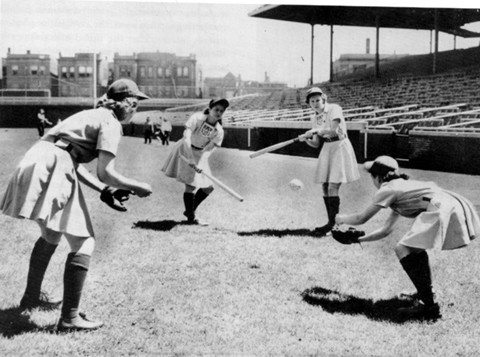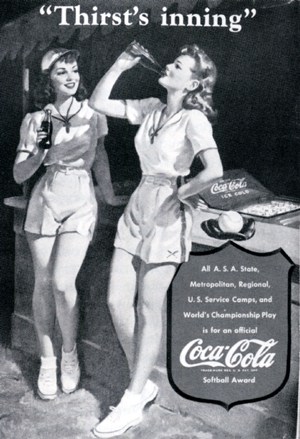
The All-American Girls Baseball League entertained a war-weary public with its calculated combination of feminine charm and masculine athletic ability.
Photo: Dorthy”Mickey” Maguire shows her strength and skill at bat for the Muskegon Lassies.
In 1943 Chicago Cubs owner Philip K. Wrigley launched a bold new baseball enterprise. Fearful that major league baseball might collapse under wartime manpower shortages, he proposed a professional women’s baseball league.
The All American Girls Baseball League (AAGBL), as it came to be called, served a dual purpose for Wrigley. He promoted the league as a form of entertainment for a war-weary public in need of wholesome, outdoor recreation. At the same time, he used women’s baseball as a temporary replacement for the men’s game, keeping stadiums occupied and fan interest alive.
The AAGBL celebrated women’s strength and energy, but it also kindled anxieties about traditional gender arrangements in American society. Since the early twentieth century, critics of women sports enthusiasts had cast them in the negative image of „mannish athletes,” an image that questioned their femininity and raised the specter of lesbianism. Sport was considered a male activity, the domain of traditional masculine virtues of aggressiveness, competition, physical prowess, and virility. Women athletes were seen as intruders into this male realm.
AAGBL used the gender issue in sports to its advantage as an ingenious way to market its of baseball to the public. By demanding that its players combine „masculine” athletic skill with very feminine appearance, the AAGBL maintained a clear distinction between male and female roles while providing the fans with skillfully played and exciting baseball. The league thus avoided the mannish image that plagued women’s sports.
League managers could assure audiences, amazed at seeing a woman play a „man’s game,” that the players were feminine and „normal” in every other respect. Although the AAGBL did not fundamentally challenge existing concepts of massculinity and femininity, it gave a group of gifted women athletes a unique opportunity to complete with the best players in the nation in a game they loved.
The league opened in four midwestern cities: Kenosha and Racine, Wisconsin; South Bend, Indiana; and Rockford, Illinois. After a slow start attendance climbed steadily, and Wrigley’s experiment gained a foothold in the professional sport world. The AAGBL later expanded to de teams in Kalamazoo, Grand Rapids, and Muskegon, Michigan; Fort Wayne, Indiana; and Peoria, Illinois, with short-lived attempts in Chicago, Milwaukee, and Minneapolis; Battle Creek, Michigan; and Springfield, Illinois. It became much more than a wartime surrogate—spanning the years 1943 to 1954—and at its peak operated in ten cities and drew nearly a million fans.

Members of the All-Amnerican Girls Softball League- the forerunner of the AAGBL- play pepper in Wrigley Field during their first season in 1943
As it became clear that the major league men’s game would survive the war, Wrigley lost interest and sold his share of the AAGBL to Arthur Meyerhoff, his close associate and advertising agent. Meyerhoff created the Management Corp. to publicize and coordinate league teams, which typically were owned by businessmen from the sponsoring city. From 1944 through 1950, Meyerhoffs Chicago-based office managed the league with assistance from a board of directors and a league commissioner. In 1951 disgruntled team owners bought out Meyerhoff and decentralized the league’s organization during its last four seasons.
The AAGBL’s eventual collapse in 1954 should not obscure its remarkable accomplishments. For twelve seasons the league played a four- month schedule of 120 games plus a championship series. Attendance during peak years ranged from 500,000 to one million as fans eagerly turned out to root for local teams named the Daisies, Lassies, Peaches, Blue Sox, and Comets.

This 1944 advertisement showing softball players relaxing after a hard game captures the calculated blend of feminine charm and masculine athletic ability promoters sought for the AAGBL.
To be continued.
Source: The Magazine of the Chicago Historical Society
Chicago History, Spring 1989, Volume XVIII, Number 1
